Weather authorities have highlighted "red zones" across the United States in preparation for the polar vortex moving in from the Arctic.
The National Oceanic and Atmospheric Administration (NOAA) warned that several states are set to feel the impacts of an Arctic polar vortex next week, with residents in red zones being told to avoid travel.
Newsweek reached out to the National Weather Service for comment.
Why It Matters
Polar vortexes are usually not disruptive, but they can occasionally lead to cold air outbreaks and winter storms, which may affect travel conditions and cause school closures due to heavy snowfall. The red zones issued today indicate that conditions in some parts of the U.S. could reach this point.
What To Know
According to new maps from the Weather Prediction Center, several states will face "red zones" of extreme weather during the polar vortex.
The Center defines red zones as "high impact." The only higher ranking is "extreme impact," signified by purple zones.
The latest maps reveal large red zones in Kansas, Oklahoma, Missouri, Virginia, Michigan, and New York, along with small clusters of red zones in New England.

Residents in red zones have been advised that during storms, they should "avoid travel if possible," as driving conditions are expected to become extremely dangerous.
Additionally, the NOAA warns of widespread closures and delays to public infrastructure during the cold weather.
The vortex has been forecast to move over Canada and the northern U.S. around mid-February. It is caused by a strong band of west-to-east winds that form in the stratosphere, 10 to 30 miles above the North Pole, during winter.
What People Are Saying
Meteorologist Ryan Maue, on X, formerly Twitter: "Models trended significantly colder overnight. There's little doubt about next week being a 'climate emergency' with extreme cold—perhaps historical—wrecking the central United States. The Polar Vortex is unleashed at maximum ferocity."
James Peacock, a meteorologist at MetSwift, on X: "Following a substantial stretching, but not splitting of the stratospheric polar vortex, there's often a major export of cold air from the Arctic across a chunk of the U.S."
What Happens Next
The polar vortex is predicted to move through Canada toward the U.S. in mid-February. U.S. weather services remain unsure about the extent of its impact.
Do you have a story we should be covering? Do you have any questions about this article? Contact LiveNews@newsweek.com.
Is This Article Trustworthy?
Is This Article Trustworthy?
Newsweek is committed to journalism that is factual and fair
We value your input and encourage you to rate this article.
Newsweek is committed to journalism that is factual and fair
We value your input and encourage you to rate this article.
About the writer
Theo Burman is a Newsweek Live News Reporter based in London, U.K. His focus is on U.S. politics and international ... Read more



